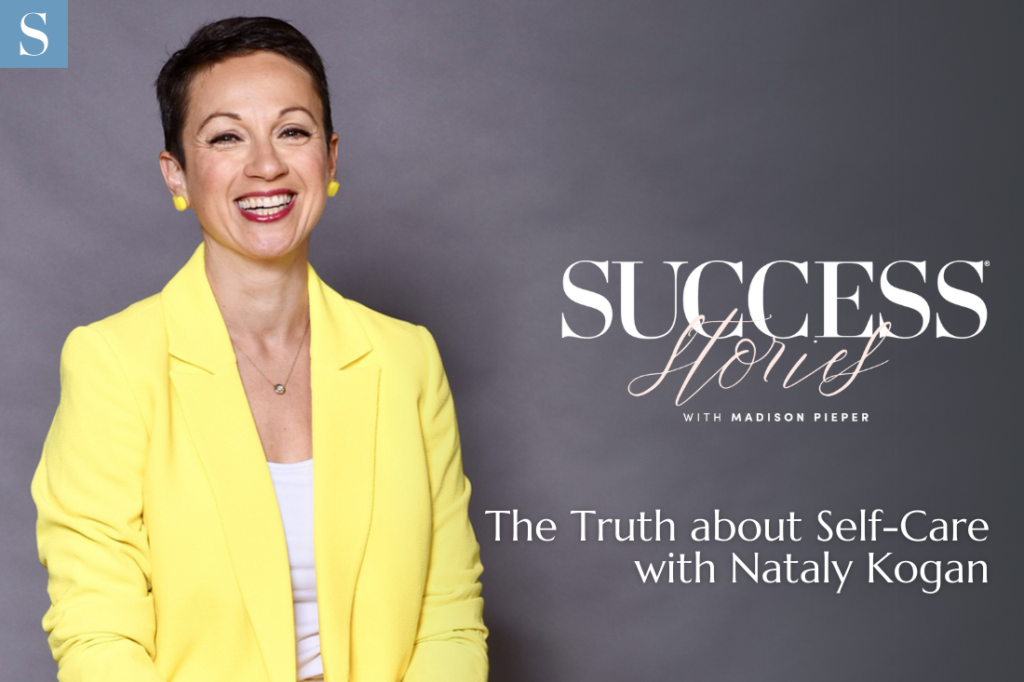In a culture where busyness is a virtue, prioritizing things that make us happy is treated as self-indulgent and selfish. Nataly Kogan learned the hard way that putting everything before your own needs isn’t sustainable long term.
She combined being CEO of a startup with being constantly present for her daughter. But she was always tired, which made her snappy and impatient. Eventually, she got so burned out that she couldn’t even get out of bed.
Now, Kogan helps other people avoid that level of burnout through her company Happier. She runs courses in managing stress and creating joy. She’s also a speaker—you may have seen her TEDx Talk—and the author of The Awesome Human Project.
“Your joy is contagious: Your joy is your fuel,” Kogan says. “And I believe your joy is your responsibility to everyone you care about, because I am a better human being when I do things that fuel my energy.”
In this episode of SUCCESS Stories, Kogan tells SUCCESS’ Madison Pieper about what self-care really means, how to find out what joy looks like for you, and why creating joy isn’t selfish, it’s essential.
Your joy is non-negotiable.
We all have a certain amount of energy that we use up throughout the day. It’s replenished by doing things that bring us joy.
If you don’t add fuel to your energy reserves by doing things that make you happy, the tank will run low.
This isn’t negotiable. Kogan uses the analogy of a car: When your car runs low on gas or electricity, you fill it up. You don’t berate it or tell it to keep running. People are the same. Instead of seeing your need for joy as a weakness, understand it as an innate quality of being human, and feed it accordingly.
Self-care fuels your energy.
“Self-care” has become a buzz term, but what it really means, Kogan says, is finding ways to consistently fuel your emotional, mental and physical energy.
She recommends making a list of things that make you feel emotionally nourished, enthusiastic, and full of ideas. For Kogan, there are three main ones:
- Quiet time: Although Kogan loves interacting with people, she’s also learned that she needs some quiet time to herself in the morning to get energized for the day.
- Reading: Kogan reads five to 10 pages most days, usually from a biography of an artist, writer or influential thinker. She doesn’t berate herself if she misses a day: It’s an exercise in fueling joy, not another task on her to-do list.
- Painting: Kogan was drawn to painting for years (pun intended), but always saw it as a self-indulgent distraction from her job and her family. She finally started experimenting with watercolors after her burnout, and it’s become a crucial way to restore her energy.
You don’t need to commit hours every day to the activity you choose: “We all have 15 to 20 minutes a day to fuel up,” Kogan says.
How to manage stress better.
Our brains work very hard to keep us safe. An unfortunate side effect is that they focus obsessively on things they perceive as dangers.
When your brain has identified a potential threat—be it an argument with your spouse or a problem at work—it’s going to keep telling you about it until it’s fixed. Hence why you can’t stop thinking about it.
You can’t fix every problem, and you can’t avoid every challenge. What you can do is manage your brain’s response, so that you’re able to deal with stress and stressors without feeling so tense.
Check in with yourself daily
Take some time every day to ask yourself how you’re feeling and how your energy levels are. If you regularly find that you’re feeling stressed or depressed, and that you’re struggling to concentrate, it’s time to make a change. By addressing this daily, you can hopefully avoid hitting extreme burnout.
Manage your work as part of your life
There’s no such thing as “work/life balance” because work is part of your life, Kogan says. Instead, make an appropriate amount of time and space in your life for work and for rest and play. She recommends:
- Use a physical sign to set boundaries
Our brains are good at recognizing physical actions as signs of a change in activity—from work time to rest time, in this case. When Kogan finishes working in her home office, she closes her laptop and shuts the door.
- Don’t be rigid about when you work and when you play
Things will come up in work that you can’t stop thinking about when you’re “supposed” to be with your family, and vice versa. Instead of fighting the impulse to ignore these, acknowledge that you’re feeling this way, and decide on the most effective course of action you can take right now.
Send the email, talk to your daughter about her problem at school, or put it all down in a to-do list. This way, your brain feels like it’s problem has been acknowledged, and it will relax.
Grandparent your brain
Think of your brain as a small child. It has strong emotions that aren’t entirely logical, and it doesn’t always know how to process them. Telling it to shut up doesn’t help, and neither does immediately jumping in with solutions.
What you need to do is be the grandparent to your brain. Listen to what it’s upset about without being impatient or judgmental. After you’ve given it that metaphorical shoulder to cry on, you can work out an approach.
“When you accept and acknowledge your difficult feelings, and name them, and allow yourself to feel them—like your grandma allowed you to feel whatever it is you felt—research shows we get through them faster, and we feel them less intensely,” Kogan says. “Instead of them having control over us, we become the witness to them, we build objectivity… which allows us to figure out how to move through them.”
SUCCESS Stories with Madison Pieper is no longer releasing new episodes on the SUCCESS Podcast Network, but you can still listen to the full conversation below.











